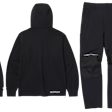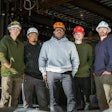
The construction industry is once again booming. The latest Associated General Contractors of America (ACG) outlook shows strong growth in construction of data centers, manufacturing and power facilities, as well as other infrastructure building. The report also notes that finding qualified workers remains “the No. 1 challenge for many contractors.” To effectively compete for a new wave of building projects, contractors must encourage diversity among construction employees. The typical construction crew today looks much different than 50 years ago, or even 10 years ago.
Today, women make up nearly 10% of the U.S. construction workforce. That number is anticipated to grow as our economy grows and more and more women choose building and trades careers. Yet, in this survey from The Center for Construction Research and Training, 77% of tradeswomen said they were exposed to unnecessary hazards because of ill-fitting personal protective equipment (PPE). That’s a major problem in the industry today.
The need for PPE that fits a variety of body types is a key topic for the construction industry. Below, we take a look at the hazards of incorrectly fitted PPE and best practices for protecting your employees, while also keeping your construction sites safety compliant.
Risks of ill-fitting PPE
Poorly-fitted PPE creates a whole new set of hazards, rendering the equipment ineffective, and even a danger to wear. Workers can’t perform at 100% if they’re wearing uncomfortable clothing. Gear that is too large, or too small, causes workers to lose focus on the task at hand. Instead, they are restricting their movement and straining muscles to try to hold their protective gear in place. Consider the following scenarios:
- Clothing that is too large or loose increases trip and fall risks.
- Improperly fitted gloves could lead to a worker getting caught in machinery.
- High-visibility clothing – reflective strips on a “standard size” vest or pants aren’t effective if they are placed on a smaller body frame. The strips are likely to be lost in the gaps or folds of the clothing.
- Improperly-secured safety glasses make workers vulnerable to chemicals and dust.
- Men’s work boots can be too large for a woman’s foot, so in addition to uncomfortable shoes causing blisters, her toes won’t be protected by the steel cap.
- Safety helmets that are too large will be wobbly and can obscure vision, cause headaches and neck strain, or simply fall off the worker’s head.
- Poor-fitting fall-arrest harness could quickly lead to suspension trauma or worse – death.
Best practices for safeguarding your construction team
Most contractors publicize the importance of safe working practices, and also keep up-to-date on current jobsite safety and compliance laws. The best contractors put their money where their mouth is, living and breathing safety on a daily basis.
In an era where finding good people is often named the “#1 challenge,” we all need to focus on attracting and retaining great people. Properly equipping employees for their specific job requirements is a tangible display of their value. This practice keeps employees safe, and creates a workplace environment people want to join.
Here are best practices to mitigate risk to your team’s safety, your Experience Modification Rate (EMR) and your Lost Time Incident Rate (LTIR).
- Leverage available resources. An abundance of material is available online to support employers and employees in keeping workers safe and job sites compliant. For example, OSHA and NAWIC developed an alliance that provides guidance and training on worker safety rights and employer responsibilities. The site resources include a sample request for fitted PPE gear, informational videos and more.
- Break the unisex and one-size-fits-all belief cycle. Stock PPE in a wide variety of sizes and fabric types for men and women. Honor each employee’s gender, shape, size and cultural practices.
- Choose safety gear based on quality and fit, not cost. Buying in bulk can save a few dollars, but could cost a life. Encourage employees to return improper-fitting PPE for properly fitted replacement gear.
- Empower your employees to advocate for themselves and one another if they see or experience improper-fitting PPE on the jobsite. Provide regular training and assure all workers understand the importance of PPE and the risks of ill-fitting PPE. Do not tolerate non-compliance with proper PPE wear and gear.
Prepping your team and company for success
Successful employers instill confidence and safe-working practices in employees by properly training them and outfitting them for the work they do each day – preparing them to work hard and work smart. That level of work leads to higher productivity and enhanced profits. Most importantly, it leads to more employees returning home safely to their families each evening.
















